
views
Understanding THC and Drug Tests

Know the factors that determine your detectable period. After using pot, THC, its primary psychoactive ingredient, remains in the body. The length of time that THC (or its metabolites - chemicals produced as it is broken down) can be detected in your system is different for everyone and depends on a number of health and lifestyle factors (see below). Metabolism. Your metabolism plays a part in how quickly or slowly the THC metabolites are broken down and released from your system. Everyone has a different rate of metabolism determined by their height, weight, sex, level of physical activity, and genetics that determines how quickly THC leaves your system. Body fat. THC is stored in fat cells. This means that, after use, THC is most densely concentrated in fatty organs like the brain, ovaries, and testicles. However, THC metabolites also have been detected in body fat for up to a month after ingestion. Frequency of usage. The frequency with you use marijuana helps determine the length of your detectable period. Because THC and its metabolites linger in the body even after a noticeable high has faded, frequent use will cause these chemicals' levels to "build up", eventually plateauing at an elevated level. Thus, heavy users will generally test positive for longer than light users if they both cease using marijuana at the same time. Potency. The potency of the marijuana also has an effect on the length of time it stays in your body. Strong pot - that is, marijuana with a high level of THC - will stay with you longer than low-grade weed. Exercise/lifestyle. The level of exercise a person gets is known to affect the level of THC in his or her system - what's less well-known is precisely how it affects this level. Contrary to the popular legend which claims that exercise can "release" TCH from the body by burning fat cells, some scientific studies have actually found the opposite in the short-term - in other words, exercise the day after ingesting marijuana can slightly elevate blood THC levels.
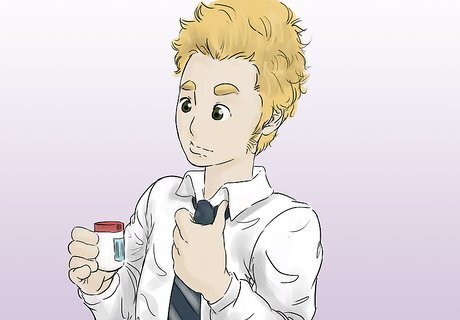
Know if you're a likely candidate for a drug test. If your prospective employer has about 100 employees or has government or private financial backing, you will probably be tested, either as part of your pre-employment screening or at some point during your tenure with that company. The Department of Defense requires frequent, observed tests of its military personnel, and parole/probation officers are subjected to a similar style of screening. In certain industries, like the restaurant and hospitality sectors, testing is much rarer, but by no means nonexistent. Note that, while urine tests can be used to test for pregnancy and certain other medical conditions, your employer has no legal basis to do so and, according to the U.S. Equal Employment Opportunity Commission (EEOC), is in fact prohibited from denying you employment based on one of these conditions.
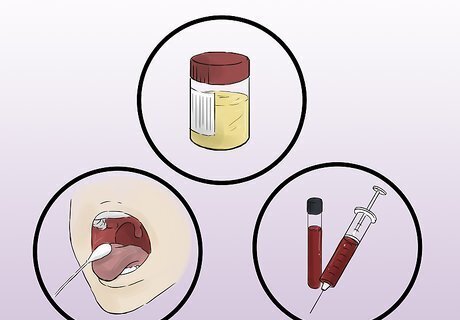
Know the different kinds of drug tests you may face. There are a number of different ways that employers screen for THC in your system. They vary in terms of cost, convenience and accuracy. This means that most employers (but certainly not all) employers will use the cheaper methods, while employers offering high-responsibility positions may require the more expensive tests. Below are the most common forms of testing: Saliva test. The saliva test, in which a sample is taken from inside the mouth via swab, is inexpensive and has a very short detection timeline. Theoretically, it can detect THC only within a few days of use. Some employers like saliva tests because they're convenient to administer, make random testing easier, and are tough to beat. However, saliva tests are thought to be fairly unreliable and are not yet widely used in the U.S, though they are prevalent in certain other countries, like Australia. Urine test. Urine tests do not actually detect THC in the body. Instead, they search for its metabolite, THC-COOH, which is produced after ingesting cannabis and can linger long after the THC itself is gone. There are two types of urine tests an employer may order: In the first, most-common type, you are required to go to an off-site collection facility. There, your urine is collected in a specially designed cup, sealed with a tamper resistant tape, and sent to a testing laboratory for screening. A second, more cost-effective method that is gaining popularity is an instant, on-site urine test that's often used for random employee testing and patient testing as well as in drug rehabilitation programs. Blood test. Blood tests test the blood itself for the presence of THC. Since THC only stays in the blood for a short amount of time (usually about 12-24 hours), this is an uncommon option for pre-employment screening. Instead, blood tests are usually used to determine whether someone was recently impaired in situations where this information is pertinent (like, for instance, after a workplace accident). Hair follicle test. These tests are somewhat expensive and are most commonly used for highly sensitive jobs or jobs that requires special clearance. Depending on the length of the hair, hair tests can show results that date back up to about three months. Hair tests are widely used in the casino industry.
Getting Clean

Be skeptical. The internet is full of misinformation and half-truths when it comes to beating drug tests. Many of the most commonly-cited tricks and home remedies aren't supported by any scientific evidence whatsoever. Thus, it's important to be very skeptical before trying one of these methods to avoid wasting your time and money or needlessly failing your test. The methods in this section may help you but are by no means guaranteed to work. Applied improperly, some of these methods can even increase the chance that you fail your test, so proceed with caution.

Try the dilution method. The dilution method for beating a urine test works on the principle that, since a positive or negative result is based on the concentration of THC metabolites in your urine, giving yourself extremely dilute urine can bring your concentration below 50ng./ml (the cut-off point for most drug tests), allowing you to pass the test. Unfortunately, many urine tests now account for this strategy, requiring the use of several countermeasures. See below for a brief guide to "dilution". Starting three days before your test, build up the creatinine levels in your system. Do this by eating a lots red meat or taking creatine supplements (available in specialty health food, vitamin and supplement stores). This first step is important because many urine tests check for this substance (a metabolite of creatine) to make sure that your urine isn’t diluted. Failure to take this step can cause you to fail the test on suspicion of diluting your urine. An hour or two before the test, take 50 to 100 mg. of B2, B12 or B-complex to add color to your urine. Then, drink a glass of water every 15 minutes or so. You should drink about a quart (roughly a liter) of water. Don't overdo your water intake to the point of water intoxication - a real and lethal condition. You should also urinate at least once during this time because you don't want to submit your first urine sample for testing. When it is time to give the sample, take it “midstream”, in other words, first pee into the toilet and then into the collection cup. This will give you the best chance of the lowest concentration of metabolites, as this flushes any old (higher-concentration) urine from the urethra. If your urine comes off as too dilute, and you get a second chance to take the test, schedule it as far out as possible. This will give you time to either reach the end of your detectable period or to try the dilution method again, making adjustments so that you don’t over-dilute. Drinking water will not “flush" the THC out of your system; it simply serves the purpose of diluting your urine.

Alter your hair. Hair tests require the person administering the test to cut a short lock of hair from your head - no hair, no test. In such a case, the test-giver may ask for a sample of body hair. To avoid this, you could conceivably shave every hair on your body before the test and claim that you’re a body builder or swimmer. However, if you appeared for your initial interview with a full head of hair or noticeable body hair, your employer will likely suspect that you're cheating. Thus, the best policy may be to shave before the interview itself so that your story is consistent.
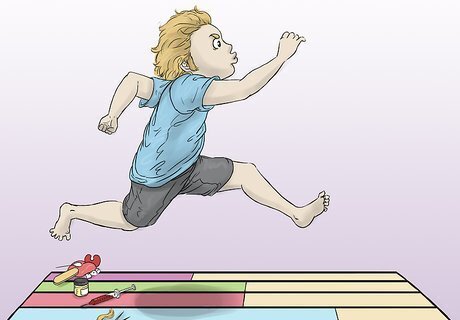
Take advantage of "gaps" in the tests' detection windows. Every type of marijuana test has a different "window" in which it tests for THC or its metabolites. Thus, if you can time your test (and/or your marijuana use) so that your last usage falls outside of this window, you can improve your chances of passing (though not guarantee them). Notably, most hair tests are unable to detect pot use within the last few days because the length of hair in which THC from this use is present has not yet emerged from the scalp. Below are the detection windows for the common methods of marijuana testing, assuming a single use of marijuana: Saliva test - 12-24 hours after use Urine test - 1-3 days after use Blood test - 1-3 days after use Hair test - from 3-5 days after use up to 90 days after use Note - for heavy users, these windows will be substantially less forgiving.

Stall for time. When all else fails, try to postpone or re-schedule your test. Every extra day you give yourself increases the chance that you'll pass your test unscathed. Even just a day or two can make a significant difference. For instance, one (admittedly informal) study found that, under the right circumstances, certain types of urine tests can give "clean" results in as little as 24 to 48 hours after marijuana use.
Dispelling Drug Test Myths
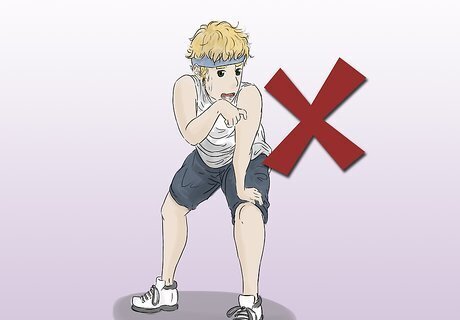
Don't try to "sweat it out". As noted above, one widely-spread home remedy for "cleansing" the body of THC is to sweat it out - usually via exercise, but sometimes via sauna. The reasoning behind this method is that THC is stored in the body's fat cells, so sweat-inducing, fat-burning activities will cause the THC to be excreted through sweat. In fact, there is no hard evidence supporting this claim. While exercise can boost the body's metabolism and thus might logically decrease the amount of time that THC remains in the body in the long term, some studies have actually found that exercise can raise blood THC levels in the short term, making this a bad last-minute choice.

Don't bother eliminating body fat via diet. As with the method above, this method suggests eliminating fatty foods from your diet to reduce your level of body fat and, thus, the amount of tissue that THC can be stored in. For many of the reasons above, this method can also be classified as unsupported by hard evidence.
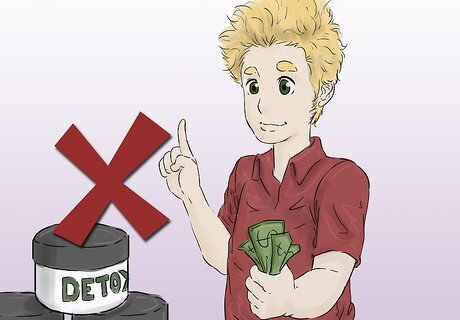
Don't waste money on a marijuana "detox" kit. Since there is no shortage of people looking for a quick way to pass a drug test, certain opportunistic companies selling supposed "detox" kits have capitalized on this captive market. Usually, these detox kits contain a regimen of pills or supplements designed to "cleanse" your system of THC and its metabolites before your tests. There is no scientific evidence supporting these companies' claims that vitamins or supplements can remove THC from your system. Any testimonials of testing negative after taking such supplements should be regarded as occurring in spite of, rather than because of the supplements.

Don't ruin your hair with special shampoos or solutions. One widely-circulated rumor regarding hair tests is that washing with a specially formulated (usually fairly expensive) shampoo can eliminate THC from the hair. In fact, no shampoo has been scientifically proven to eliminate THC. In addition, some "home remedy" versions of this method recommend creating a solution from chemicals like bleach which can potentially irritate your scalp. When it comes to marijuana tests, use a healthy amount of discretion whenever rubbing strong chemicals into your hair - just as you normally would.

















Comments
0 comment